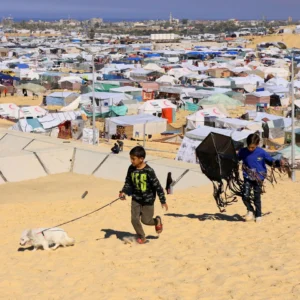If the Israeli Army Invades Rafah, What Will Become of More Than 1.5 Million Palestinians Sheltering There?

Tents for displaced Palestinians in Rafah, southern Gaza Strip, on Friday.Credit: Saleh Salem / Reuters
Since Yahya Sinwar, his close aides and Hamas militants have never been found in Gaza City and then not in Khan Yunis, the Israeli army is considering expanding its ground operation into the southern Gaza city of Rafah. The army is doing so because it assumes that Sinwar and his aids are hiding in the tunnels underneath this southern region of the Gaza Strip, presumably holding on to the Israeli hostages who are still alive.
Most of the Gaza Strip residents, some 1.4 million people, are concentrated in Rafah. Tens of thousands are still fleeing into the city from Khan Yunis, where the fighting continues. The thought that Israel will invade Rafah and that fighting will take place between and near civilians terrifies the city’s residents and the internally displaced persons. The terror they feel is augmented by the conclusion that nobody can prevent Israel from carrying out its intention – not even the ICJ ruling that orders Israel to take all measures to avoid acts of genocide.
Military correspondents in Israel report and assume that the army intends to order residents of Rafah to move to a safe area. Since the war started, the army has been waving around this evacuation order as evidence that it is acting in order to prevent any harm to “uninvolved civilians.”
This safe zone, however, which was bombarded and still is bombarded by Israel, is gradually shrinking. The only safe zone that truly remains, and which the IDF is now designating for the masses of people in Rafah, is Al-Mawasi – a southern Gaza coastal area of approximately 16 square kilometers (about 6 square miles).
It’s still unclear by what verbal measures the IDF and its legal experts intend to reconcile this squeezing of so many civilians with the orders given by the ICJ.
“The humanitarian zone designated by the army is around the size of Ben-Gurion International Airport (about 6.3 square miles),” concluded Haaretz journalists Yarden Michaeli and Avi Scharf in their report earlier this week. The report, titled “Gazans Fled Their Homes. They Have Nowhere to Return to,” revealed the vast devastation across the Gaza Strip as captured in Satellite images.
The comparison with Ben-Gurion International Airport invites one to imagine a density beyond anything imaginable, but Israeli TV commentators don’t go much further beyond the deep insight that the ground invasion of Rafah will indeed, “won’t be that simple.”
Although it’s difficult, we must imagine what awaits the Palestinians in Rafah if the army’s plan is carried out. We must do so not so much as of humanist and moral considerations, which after October 7 aren’t that relevant to the majority of the Israeli-Jewish public, but because of the military, humanitarian, and – eventually – legal and political entanglements that are surely expected if we go down that road.
